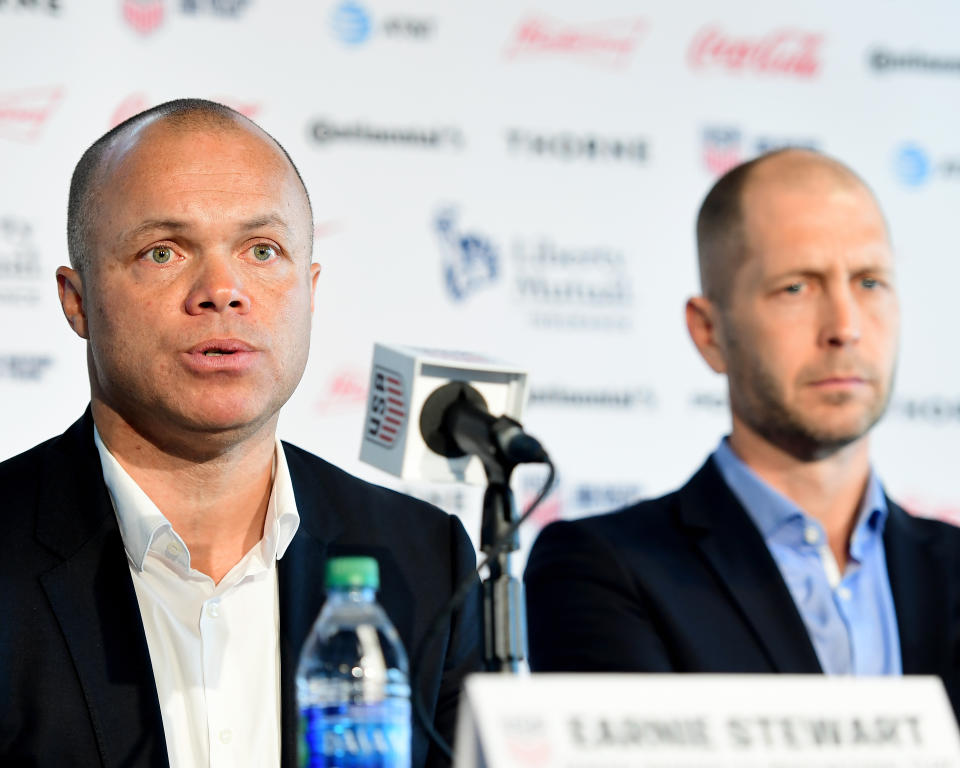How the USMNT backed itself into a 2022 World Cup qualifying corner

Earnie Stewart arrived with a vision. For better or worse, on a momentous Chicago morning last August, U.S. Soccer’s first general manager walked through the gates at 1801 S. Prairie Ave. to stabilize a rudderless program. He came with a plan. A few months later, he hired a coach to implement it. And finally, after years of clamoring for some direction, U.S. men’s national team fans had what they’d clamored for.
Stewart’s arrival represented a stark departure from the scatterbrained reign of Jurgen Klinsmann. A welcome end to the aimless interim. Stewart brought in Gregg Berhalter, and almost immediately, the program was everything we, the USMNT collective, had craved. It had definition. Purpose. A distinctive style, governed by a refined philosophy and core principles, and a coach who’d have time to instill them.
He’d have time because he’d need time. Because the on-field behavior he’d need to teach would take months, if not years, to engrain. The process, at times, would be painful. The results along the way would spark concern. Stewart knew this; acknowledged it; accepted it. Most rational fans agreed to the terms and conditions as well.
But now, less than a year after that acknowledgement, alarm bells are ringing. Not inside Soccer House, but all around it. The first 11 months of what we’d hoped to one day call The Berhalter Era haven’t been dreadful, but have ignited legitimate worry. Worry that the plan is misguided. That the coach is ill-suited. That the vision is, was, always has been idealistic and impractical.
Worry, however, is normal. The USMNT’s struggles, on the other hand, inspire fear. Because all those suspicions? They cannot possibly be confirmed until it’s too late.
Until another World Cup cycle is lost.
And Stewart, in all likelihood, will not act on them anytime before then.
Club USMNT
Before signing their contracts with U.S. Soccer, neither Earnie Stewart nor Gregg Berhalter had spent a day of their non-playing careers with a national team. Stewart had helmed three clubs. Berhalter had managed two. And his plan, essentially, was to treat the USMNT like a third. To install a complex system, replete with nuanced decision trees and principles of play. And to drill players in that system until they mastered it.
Evidence of the plot was everywhere this past summer. On one brilliant June day in Minnesota, after U.S. training, Weston McKennie made the relevant comparison before I could even ask about it. “We work on a lot of the tactics in Germany,” he told Yahoo Sports of his time with Schalke. “And we watch quite a bit of video. And we do the same thing here.”

Berhalter is known for his borderline-maniacal attention to detail, and he has applied it to his new gig. He and his staff have done everything to maximize their time with players, such as flying drones at practice and poring over the film they capture for hours afterward. Coaches even communicate with players outside of international windows, sending instructive video clips via apps. “As much as I want,” Aaron Long told Yahoo Sports of the exchanges with coaches. “I can contact them, they watch every game, they reach out to me after some games.”
But the inescapable reality of Berhalter’s job is that club teams spend roughly 36 weeks together every year. National teams, on average, get only eight. They can’t purchase players based on need. They often convene for fewer than 10 days at a time, rarely with consistent attendance. They rely on players’ abilities to absorb information, store it away in their brains after leaving brief training camps, retain it beneath club teachings, and access it months later.
At best, therefore, a four-year national team cycle is analogous to one club season. And a few months into one club season is no time to panic about a new manager. Berhalter’s opportunities to hammer home concepts, even through a full year on the job, have been relatively scarce. He has had his three best players on the field together for a grand total of 62 minutes. His tenure, when considered in those terms, is still nascent.
But a World Cup cycle is not a club season, because a disappointing club season is not catastrophic. For U.S. Soccer, a World Cup flameout or another failure to qualify would be. And the USMNT’s current trajectory is taking it dangerously close to that scorching sun.
To a degree, Stewart and Berhalter knew that it would. This, again, was their chosen path.
What they can’t know, given the lack of USMNT precedent for this extreme club-style approach, is whether their path actually leads to where they envision it leading.
Does the USMNT need a defined style?
None of which is to say that entrenched systems can’t work at international level. One led Spain to three consecutive titles from 2008-2012. Another led Germany to the top of the world in 2014. Both case studies informed USMNT fans’ desire for an equivalent. For an American style. For what Stewart was tasked with defining.
Over a year later, it’s something he still sees as integral to his project. “Consistency and continuity will actually bring you to where you need to be,” he said Tuesday on a conference call. “And changing, every time, systems, tactics, I don’t believe in that. I really don’t believe in that. And to be quite frank, all the successful teams that there are in the world, that have become world champion, or European champion … usually are those teams that have been very consistent in what they’ve been doing. Not only with their players, but with their style of play.”
His argument, however, is flawed. Not only because the reigning European and world champions won without long-standing styles, but because no world champ’s example is applicable to the USMNT. Perhaps Spain and Germany won in part because they developed enduring styles. But they were able to develop enduring styles because they have the talent to impose themselves on any opponent.
The USMNT doesn’t. Certainly not in the ball-dominant way Stewart and Berhalter want it to. Its deficiencies require pragmatism. Deviations from the plan that the two men in charge haven’t seemed willing to embrace.
“You need to be able to hang your hat on something, and fall back on something,” Stewart continued Tuesday. “And if you don’t have that organization … it can go in a really bad way. And then you get this roller-coaster ride, where you throw the ball in the middle, and if you’re better than the opponent this day, OK, you’ll win a game, and if you’re worse, you’ll lose a game. And that’s not what we want to be.”
Yet doesn’t that – a team that plays to its talent level – sound better than what they currently are?

The USMNT’s dilemma
The evasive answer, once again, is that they are progressing toward a long-term goal. That where the USMNT is right now matters very little compared to where it will be in 2021 and 2022. “We have a vision,” Stewart reiterated Tuesday. “And once you set that vision … you need to stick to it.”
But for how long? Surely not forever. Surely not despite a spate of negative results. Surely, somewhere along the path, there is a melting point.
This is the USMNT’s dilemma, a looming clash of a desire and an imperative. On one hand, fans and the federation alike wanted progress – toward something, whether a philosophy or system, that will survive coaching changes and across generations.
On the other hand, the USMNT absolutely cannot afford to miss another World Cup.
To be clear, it probably won’t. We are a long way away from that clash actually occurring. Berhalter will, at the very least, get a couple qualifiers. Smart money would be on a full four years.
But what if, at this time next year, Stewart’s vision hasn’t yet materialized? At what point would he pull the plug? Scrap the progress? Send the program tumbling back to square one, in a desperate attempt to secure a trip to Qatar?
The answer is that he can’t. Because he’s committed to a plan whose validity is unknowable until it either does or doesn’t yield the envisaged result. At any point, it could. Underlying progress, the type Berhalter and Stewart saw in a 3-0 loss to Mexico, could bubble to the surface, bringing not only immediate success but sustainable success. That is the ultimate goal. As long as it exists as a possibility, Stewart has to stay the course.
But just because the possibility exists doesn’t mean actual success ever will.
Stewart, therefore, has backed himself into a dangerous corner. The longer the USMNT struggles, the lonelier he’ll get. But you better believe he’ll be the very last one to leave it.
– – – – – – –
Henry Bushnell is a features writer for Yahoo Sports. Have a tip? Question? Comment? Email him at henrydbushnell@gmail.com, or follow him on Twitter @HenryBushnell, and on Facebook.
More from Yahoo Sports:

